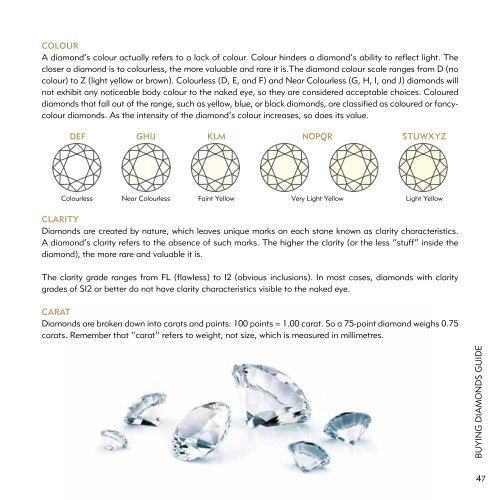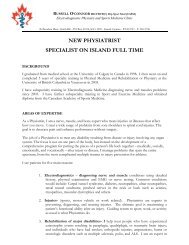GRAND CAYMAN SHOPPING - Ecayonline.com
GRAND CAYMAN SHOPPING - Ecayonline.com
GRAND CAYMAN SHOPPING - Ecayonline.com
You also want an ePaper? Increase the reach of your titles
YUMPU automatically turns print PDFs into web optimized ePapers that Google loves.
COLOUR<br />
A diamond’s colour actually refers to a lack of colour. Colour hinders a diamond’s ability to reflect light. The<br />
closer a diamond is to colourless, the more valuable and rare it is.The diamond colour scale ranges from D (no<br />
colour) to Z (light yellow or brown). Colourless (D, E, and F) and Near Colourless (G, H, I, and J) diamonds will<br />
not exhibit any noticeable body colour to the naked eye, so they are considered acceptable choices. Coloured<br />
diamonds that fall out of the range, such as yellow, blue, or black diamonds, are classified as coloured or fancycolour<br />
diamonds. As the intensity of the diamond’s colour increases, so does its value.<br />
DEF GHIJ KLM NOPQR STUWXYz<br />
Colourless Near Colourless Faint Yellow Very light Yellow light Yellow<br />
CLARITY<br />
Diamonds are created by nature, which leaves unique marks on each stone known as clarity characteristics.<br />
A diamond’s clarity refers to the absence of such marks. The higher the clarity (or the less “stuff” inside the<br />
diamond), the more rare and valuable it is.<br />
The clarity grade ranges from Fl (flawless) to I2 (obvious inclusions). In most cases, diamonds with clarity<br />
grades of SI2 or better do not have clarity characteristics visible to the naked eye.<br />
CARAT<br />
Diamonds are broken down into carats and points: 100 points = 1.00 carat. So a 75-point diamond weighs 0.75<br />
carats. Remember that “carat” refers to weight, not size, which is measured in millimetres.<br />
BUYING DIAMoNDS GUIDE<br />
47








